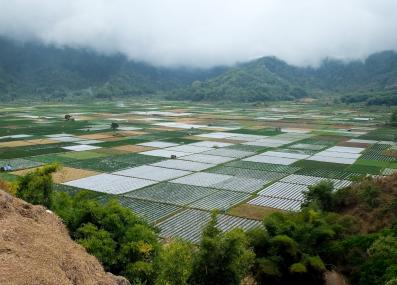Have a question?
How should we measure the CO2 emissions from biofuels and bioenergy?
To know if bioenergy is truly a low-carbon resource, we must count emissions from growing, transporting, and processing the associated crops, check whether those crops were replanted, and add in any emissions from creating farmland to grow more of them.
January 9, 2024
Organic materials like corn, soybeans, or wood can be turned into energy, either by refining them to produce liquid “biofuels,” or by burning them for heat, which can then be used to produce electricity.
Is this a “carbon-neutral” alternative to coal and gas power—one that doesn’t add climate-warming carbon dioxide (CO2) to the atmosphere? Some scientists and policymakers think so, because plants recycle carbon. When burned, plants release carbon, but they also take up carbon from the air when they regrow. This cycle means the overall carbon impact is, at least hypothetically, neutral.
“If you do that in a neat loop, all the carbon that we are generating from burning biomass is going to be sequestered again,” says Angelo Gurgel, a research scientist at the MIT Joint Program on the Science and Policy of Global Change.
In practice, that loop is rarely neat, and measuring the carbon impact of bioenergy is complex. Crops used for bioenergy must be continually replanted to stay “carbon-neutral.” Some, like trees, take decades to regrow, so harvesting biomass can outpace replanting.
Wood-fired power plants also produce more CO2 than coal plants per unit of electricity produced, so in the short term CO2 in the atmosphere can rise if bioenergy replaces coal.1 And other climate emissions are also tied to processing biofuels and bioenergy—emissions that don’t come from the carbon in the plants themselves. For all these reasons, how biofuels are made, and what crops they’re made out of, is crucial to their ability to provide truly low-carbon energy. Some studies have even concluded that, in specific cases, biofuels can lead to higher CO2 emissions than the fossil fuels they replace.2
To measure the emissions associated with bioenergy, Gurgel says scientists must first calculate the emissions associated with their production, transport and processing. That includes emissions from the farm machinery used to harvest them, and the gasoline burned to move them to a processing facility. In some cases, it can also include the fossil fuels used to run the processing plant.
Estimating emissions from all of those activities is relatively simple, though. “It's quite standard, doing that kind of measurement,” says Gurgel.
The calculations get more complicated when we add the second category of emissions that Gurgel says we should consider: how land use changes to produce more crops for bioenergy. In 2023, land use change (including but not exclusively from bioenergy) accounted for about 10 percent of global climate emissions.3
Today, most biofuels come from crops such as corn and sugarcane. When there’s more demand for those fuels, farmers are more inclined to grow them, potentially clearing forest or other natural ecosystems for new farmland. Since most natural ecosystems absorb and store carbon, while farmland in active use tends to produce it, this land use change can create more climate-warming pollution. On the other hand, if farmers meet demand by converting pasture land or increasing yields on current farmland, growing crops for bioenergy can absorb more carbon than the land would have otherwise, benefiting the climate.
But modeling this land use change, and incorporating it into CO2 measurements for bioenergy, is difficult, says Gurgel. “Usually, we only can measure that ex-post, after we have seen the biofuels industry has grown,” he says.
Scientists can use remote-sensing to determine how much land has changed, or analyze public records of land use.4 But how producers will respond to future demand over time is hard to estimate. Plus, it’s difficult to tell if land use changed because of biofuel demand, or for other reasons. There’s little consensus on how to measure these influences, says Gurgel. Though scientists are continuing to work on these questions, he says they may never determine exact numbers with certainty, only trends.
“What's the best method? What's the best model out there to do that kind of measurement?” asks Gurgel. “The models are not ready and probably will never be.”
Thank you to Greg Perryman of East Melbourne, Australia, for the question.
Submit your own question to Ask MIT Climate
Get the latest from Ask MIT Climate monthly in your inbox
1 Sterman, John, Lori Siegel, and Juliette N Rooney-Varga, "Does replacing coal with wood lower CO2 emissions? Dynamic lifecycle analysis of wood bioenergy." Environmental Research Letters, Volume 13, Issue 1, 2018, doi:10.1088/1748-9326/aaa512.
2 Lark, Tyler, et al., "Environmental outcomes of the US renewable fuel standard." Proceedings of the National Academy of Sciences Environmental Sciences, Volume 119, Issue 9, 2022, doi:10.1073/pnas.2101084119.
3 Friedlingstein, Pierre, et al., "Global Carbon Budget 2023." Earth Systems Science Data, Volume 15, Issue 12, 2023, doi:10.5194/essd-15-5301-2023.
4 World Resources Institute and World Business Council for Sustainable Development: "Greenhouse Gas Protocol: Land Sector and Removals Guidance: Calculation Guidance." Draft for pilot testing and review, September 2022.









